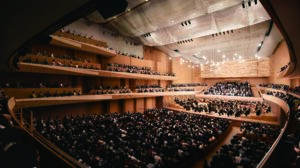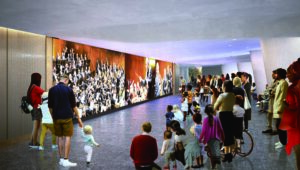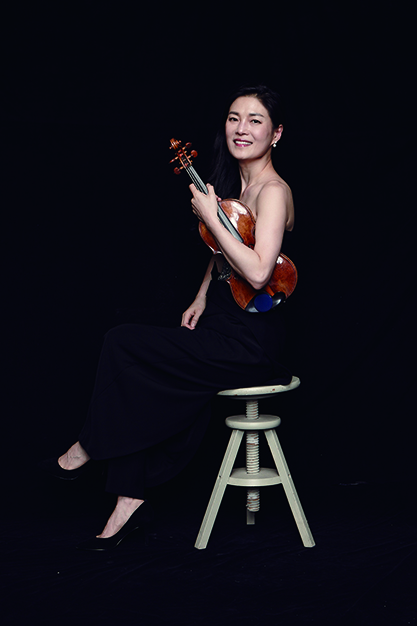노먼 레브레히트 칼럼 | SINCE 2012
영국의 평론가가 보내온 세계 음악계 동향
코로나19 여파 속 미국 음악계의 희망
새로운 청중을 위한 데이비드 게펀홀

데이비드 게펀홀 예상도 ©Diamond Schmitt Architects
반쪽짜리 메트로폴리탄 오페라(이하 메트 오페라)는 2월 내내 문을 닫았다. 뉴욕 필과 시애틀심포니의 음악 감독인 네덜란드인과 덴마크인은 일터를 떠나 버렸고, 유럽의 유명 인사들 역시 그럴싸한 변명만 늘어놓았다. 오케스트라 열두 곳은 EDI(평등, 다양성, 포용)를 갖춘 부대표를 고용했고, 미국 최정상 현악 4중주단 에머슨 콰르텟은 은퇴를 선언했다. 음악 교수들은 꼭두새벽부터 법정에 소환되었고, 스티븐 스필버그의 영화 ‘웨스트 사이드 스토리’는 투자금액 대부분을 잃었다.
링컨 센터의 효율적 재단장
이 지난한 터널의 끝에는 모든 상황을 뒤집을 수도 있는 희미한 빛이 반짝이고 있다. 올 10월, 뉴욕 필이 예정보다 1년 빠르게 링컨 센터로 돌아온다. 잘못 읽은 게 아니다. 새로이 단장한 데이비드 게펀홀(David Geffen Hall)이 부분적으로는 팬데믹 덕분에 1년이나 일찍 문을 열 예정이다. 과거에도 이렇게 빠른 공연장 개장이 있었는지 기억은 잘 나지 않지만, 별로 중요하지는 않으니 넘어가자. 공연장 토대만 남긴 채 갈아엎는 이 21세기식 공사의 견적 금액은 10억 달러에 육박했다. 하지만 링컨 센터는 헤지 펀드 관계자 정도는 돼야 방 한 칸 이상을 빌릴 수 있는 맨헤튼의 어느 구석에 자리를 잡고 있었고, 10억 달러라는 금액이 필요하다고 본 경영진은 미드타운의 거부들을 공략했다. 결과적으론 최종 공사 금액이 당초 견적의 절반에 해당하는 5억 5천만 달러로 결정됐다. 이는 믿기 어려운 일이다. 유럽의 모든 공연장은 공사 견적이 예산을 초과했다. 필하모니 드 파리는 5억 3천만 유로로 예산의 3배를 뛰어넘었고, 함부르크의 엘프필하모니는 예상보다 7배 증가한 7억 8천만 유로가 필요했다. 런던은 변변치 못한 바비칸홀 교체 안을 통과시키는 것조차 실패했다. 맨해튼의 사례는 우리 모두에게 수치를 안겨준 셈이다. 물론 굳건한 애호가층을 제외한 모두가 싫어하는 둔탁한 음향과 불편한 동선, 콧대 높은 분위기와 같이 일전의 악명 높은 단점을 개선하지 못한다면 이 모든 것은 논할 가치가 없다. 1962년, 실제 웨스트사이드 스토리가 펼쳐졌던 공동 주택 건물을 허문 구역에 문을 연 이 공연장은 1천 5백만 달러를 기부한 에이버리 피셔(Avery Fisher)의 이름을 따서 명명되었다. 오늘날 그 금액은 청소 비용으로도 충분하지 못하니 경영진은 2015년 피셔의 이름을 지우고 자신의 이름을 공연장 문 위에 새기기 위해 1억 달러를 기부한 할리우드 거물의 이름을 따서 데이비드 게펀홀이라고 명명한다. 감성적이지도, 인정이 넘치지도 않지만 분명 이는 뉴욕만의 방식이었다.
교감을 도모하는 음향과 공간 구성

로비 예상도 ©TOD WILLIAMS BILLIE TSIEN Architects _ Partners
그럼 이번 공사는 어떻게 진행됐을까? 뉴욕 필의 대표 데버라 보르다(1949~)가 며칠 전 내게 줌(Zoom)으로 공연장 가상 투어를 시켜주었다. 그 날 이후로 나는 게펀홀이 지난날을 모두 만회하며 전 세계의 내로라하는 공연장을 따라잡으리라고 믿게 되었다.
현시점에서 음향에 대한 판단을 내리는 것은 불가능하지만, 객석 수용 인원이 2,738석에서 2,200석으로 대폭 축소되어 음향 분배가 개선될 것으로 보인다. 더 좋은 점은 좌석을 자유자재로 올리거나 제거할 수 있다는 것이다. 무대 뒤쪽 축구공 모양의 계단식 좌석은 연주자들에게 가까이 다가가길 선호하는 이들에게 이상적이다. 또한 터치 한 번으로 좌석을 접을 수 있어 오케스트라나 백스테이지 확장도 가능하다. 약 0.7m 앞 쪽으로 이동한 무대는 청중과 연주자 간의 친밀감은 물론, 보르다의 말을 따르자면 ‘더 큰 교감’을 도모한다. 천장도 더욱 높아졌으며, 측면 벽은 ‘오케스트라를 공간적으로 감싸기 위해’ 목재로 새로이 디자인됐다. 오케스트라 전체가 소리를 내보기 전까지 음향이 완벽한지 알 길이 없지만, 계획으로는 최상의 원칙에 따라 19세기 보스턴의 슈박스 형태 공연장과 함부르크·파리의 최신 빈야드 형태를 겹합했으니 당연히 좋을 수밖에 없을 것이다. 한 오케스트라 연주자는 몰래 무대 위에서 악기를 연주해보고는 음향이 정말 좋았다고 내게 귀띔해주었다.
내부에 대해서는 이쯤 해두기로 하고, 이전의 피셔홀은 마치 교도소나 금괴 저장소같이 외부에서 초대를 받아야만 들어갈 수 있는 곳 같았다. .철옹성의 틈바구니에서 출입구를 찾아낸 뒤에 맞닥뜨리게 되는 것은 사람 사이의 소통이라고는 찾아볼 수 없는 일렬의 매표소 창구였다. 몸과 마음에 생기를 불어넣어 줄 그 무엇도 이전 로비에는 없었다. 새로운 로비는 조금 다르다. 2배 규모로 확장되었으며 천장부터 바닥까지 유리로 마감되어 외부에서도 건물 내부의 모든 면면이 보여 시선을 이끈다. 곳곳에 카페가 들어오고 여기저기에 편하게 쉴 수 있는 좌석도 배치된다. 거대한 스크린으로 모든 공연이 실황 중계되어 우연히 방문한 사람도, 7번가(Seventh Avenue)에서도, 66번가(66th Street)에서도 공연을 관람할 수 있다. 벽이 없는 세계 최초의 공연장으로 자리매김할 이곳에는 무궁무진한 기회가 엿보인다. 클래식 음악계는 오랫동안 새로운 청중을 꿈꿔왔으며, 코로나가 이를 가능케 했다. 클래식 음악 애호가층 대부분이 집에서 머무는 2년 동안 젊고, 호기심이 넘치며, 다양해진 대중이 처음으로 공연장에 나타나고 있다. 공연장에서 들은 음악이 만족스럽다면 이들은 다시 방문할 것이다. 새로운 청중은 까다롭고 가격에 민감하다. 이들은 정기적으로 공연에 가진 않지만, 건물 언저리의 소규모 공간에서 진행되는 시 낭독회, 재즈 및 현악 4중주에서 부터 메시앙의 ‘투랑갈릴라 교향곡’에 이르기까지 다양한 형태의 공연을 선호할 것이다. 지금 내가 목도하고 있는 것은 미래의 공연장이다. 사람들이 자신이 선택한 방식에 따라 공연장 안에서 음악을 만끽할 수도, 일상 속에서 커피를 든 채 어울리거나 거리에서 힐끗 음악을 지나칠 수도 있는 그런 곳 말이다. 게펀홀이 줌에서 보았던 것의 반만큼이라도 훌륭하다면 분명 전 세계에서 제일가는 세기의 명소가 될 것이다. 번역 evener
노먼 레브레히트 칼럼의 영어 원문을 함께 제공합니다
본 원고는 본지의 편집 방향과 일치하지 않을 수 있습니다
The Metropolitan Opera, half-empty, shut down for the month of February. Music directors in New York and Seattle, a Dutchman and a Dane, left their jobs. Bigger European names polished their excuses. A dozen orchestras hired vice-presidents of EDI, equality, diversity and inclusion. The Emerson Quartet, America’s finest, called it quits. Music professors were hauled before woke tribunals. Stephen Spielberg’s West Side Story movie lost most of its investment.
At the end of this tunnel, there is a glimmer of light, possibly a game changer. This October, the New York Philharmonic will return to Lincoln Center, a year ahead of schedule. Yes, you read that right. The transformed David Geffen Hall will open a whole year early thanks, in part, to Covid shutdowns allowing a jump-start. I cannot remember a premature hall birth before, but that’s the least of it.
The original estimate for stripping back the hall to underpinnings and equipping it for 21st century uses was around one billion dollars. It sits, after all, in a part of Manhattan where only hedge funders can afford to rent more than a one-bed closet. A billion bucks seemed about right and execs set about tapping the midtown rich for the rest. So guess what? The final freckoning has just come in at half the price -$550 million, less change.
This is beyond belief. In Europe, everyone overspends. The Philharmonie de Paris went three times over budget at 534.7 million Euros. Hamburg’s Elbphilharmonie septupled its estimated cost at 789 million Euros. Cologne Opera will be paying interest until 2063 on its billion-Euro refurb. London cannot even get past go on replacing its wretched Barbican hall. Manhattan puts us all to shame.
None of this, of course, will amount to a row of beans unless the new hall overcomes the old one’s notorious shortcomings –murky acoustics, quirky access and a snooty atmosphere that put off all but the most determined concertgoers. Opened in 1962 on the site of demolished tenements where the original West Side Story took place, the hall was named after Avery Fisher who made the lead $10.5 million donation. That sum, these days, would barely py for cleaning so they erased Fisher in 2015 and called it David Geffen Hall after a Hollywood mogul who gave $100 million to have his name above the door. Unsentimental, heartless even, but that’s how New York does business.
So what bang will they get for those bucks? Deborah Borda, president of the New York Philharmonic, gave me a virtual tour on Zoom the other day. What I saw leads me to believe that Geffen Hall will leave the rest of the world playing catch-up.
Impossible to judge the acoustics at this stage, but capacity has been slashed from 2,738 seats to 2,200, which will improve sound distribution. Better still, blocks of seating can be raised or removed at will. A football-like terrace of seating at the rear of the stage is ideal for those of us who like to get up-close and personal with the musicians, but the seats can be retracted at the touch of a button to allow enlargement of the orchestra or a deeper backstage.
The stage itself has been brought 25 feet forward to increase intimacy between performers and public – ‘more visceral,’ says Borda – and the ceiling is higher. The side walls have been redesigned in wood with a view to ‘wrapping the orchestra with the room.’
We cannot know if the sound is perfect until the orchestra is let loose at full cry, but the plan takes the best principles of Boston’s 19th century shoebox shape and melds them with modern vineyard style of Hamburg and Paris. It ought to be good. One Philharmonic player who had a sneaky squeak of an instrument on stage tells me it really is.
So much for inside. The old Avery Fisher Hall used to look as inviting from the outside as Sing- Sing or Fort Knox. If you found a way in through a chink in the fortifications, you faced a row of box-office windows that nullified human interaction. There was little in the lobby to refresh body or soul.
The new lobby is something else – twice as big and walled from floor to ceiling by glass so that everything inside can be seen invitingly from the street. The space will be dotted with coffee stations and relaxed seating is provided all around. A giant video screen will show all concerts live and free to anyone who cares to drop in, or watch from Seventh Avenue or 66th Street. This looks like being the world’s first concert hall without walls, and the opportunities are limitless.
Classical music has long dreamed of the possibility of a new audience, and Covid has delivered one. While the hardcore subscription audience has mostly stayed home for two years, a younger, curious and encouragingly diverse public is dropping by for the first time. If they like what they hear, they come again. The new comers are picky and cost-conscious. They won’t turn out to routine concerts and they are likely to appreciate the choice of events on offer in smaller spaces around the building, anything from poetry readings, jazz and string quartets to the full Messiaen Turangalila.
What I am looking at here is the concert hall of the future. It’s a place where people can engage with music at their chosen level of intensity, total in the hall, casual with coffee, peripheral from the street. If Geffen is half as good as it looks on Zoom, it will be the world’s benchmark for a generation.

글 노먼 레브레히트
영국의 음악·문화 평론가이자 소설가. ‘텔레그래프’지, ‘스탠더즈’지
등 여러 매체에 기고해왔으며, 지금 이 순간에도 자신의 블로그
(www.slippedisc.com)를 통해 음악계 뉴스를 발 빠르게 전한다







